人教版高一必修一unit3reading教案
高一英语必修一unit3 reading 教案
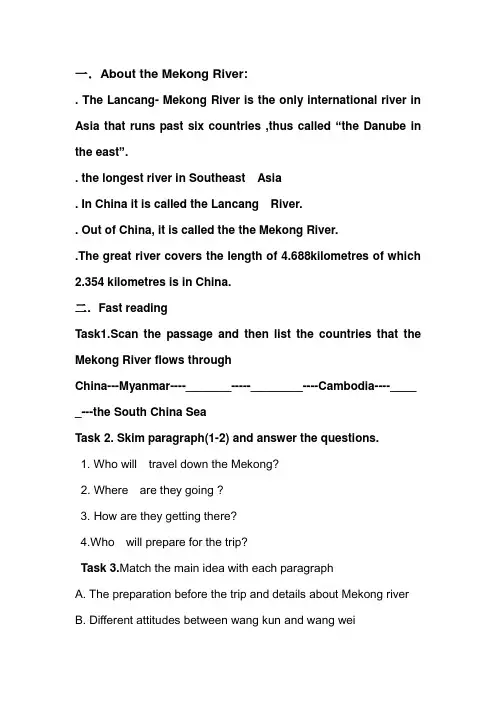
一.About the Mekong River:. The Lancang- Mekong River is the only international river in Asia that runs past six countries ,thus called “the Danube in the east”.. the longest river in Southeast Asia. In China it is called the Lancang River.. Out of China, it is called the the Mekong River..The great river covers the length of 4.688kilometres of which 2.354 kilometres is in China.二.Fast readingTask1.Scan the passage and then list the countries that the Mekong River flows throughChina---Myanmar----_______-----________----Cambodia----____ _---the South China SeaTask 2. Skim paragraph(1-2) and answer the questions.1. Who will travel down the Mekong?2. Where are they going ?3. How are they getting there?4.Who will prepare for the trip?Task 3.Match the main idea with each paragraphA. The preparation before the trip and details about Mekong riverB. Different attitudes between wang kun and wang weiC.Dreamed of taking a great bike along the Mekong rive 三.Careful reading (Detail reading)Task1. Reading through paragraph 2, then decide true or false.1. Wang Wei does not care about the source of the river.2. Wang Wei had looked at a map before she started her journey.3. Wang Kun though it would be an interesting experience.4. Wang Wei thought it would be hard to breath there.5. According to Wang Kun, Wang Wei is a stubborn girl.Task 2 Reading through paragraph 3 then fill in the blanksThe Mekong River begins ___ a ______on a ______mountain. At first ,The river is small and the water ________.Then it begins to move_______. It becomes ______as it passes ______ deep_____. Sometimes The River ______ wide Valley and becomes a_________. We were both surprised to learn that half of the river is in China . After it leaves china and the high ______, the Mekong becomes _____ , brown and warm. As it enters Southeast Asia, its ____slows.It makes wide ____or______through low _____ to the_____where rice grows. At last the river delta enters the South China Sea.New words about geographyaltitude 海拔高度;glacier 冰河rapids急流valley(山)谷;waterfall 瀑布plain 平原delta 三角洲四.Listening to the text and find Some useful words and phrase1.骑自行车旅游2.梦想做某事3 .说服…做…4.关心,介意5.改变主意6.下定决心7.屈服,让步8.使某人对·····感兴趣The great rivers in the world*oTian’anmen SquareThe Great Wall Forbidden City The Heaven Temple。
人教版英语必修一Unit 3(主题阅读课)教学设计
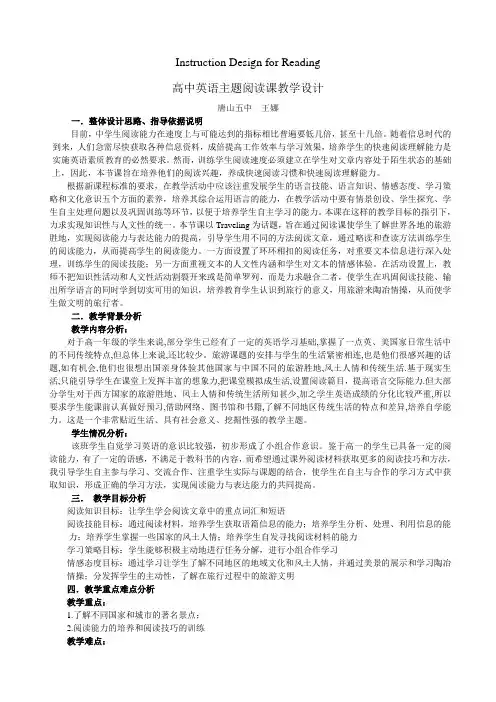
Instruction Design for Reading高中英语主题阅读课教学设计唐山五中王娜一.整体设计思路、指导依据说明目前,中学生阅读能力在速度上与可能达到的指标相比普遍要低几倍,甚至十几倍。
随着信息时代的到来,人们急需尽快获取各种信息资料,成倍提高工作效率与学习效果,培养学生的快速阅读理解能力是实施英语素质教育的必然要求。
然而,训练学生阅读速度必须建立在学生对文章内容处于陌生状态的基础上,因此,本节课旨在培养他们的阅读兴趣,养成快速阅读习惯和快速阅读理解能力。
根据新课程标准的要求,在教学活动中应该注重发展学生的语言技能、语言知识、情感态度、学习策略和文化意识五个方面的素养,培养其综合运用语言的能力,在教学活动中要有情景创设、学生探究、学生自主处理问题以及巩固训练等环节,以便于培养学生自主学习的能力。
本课在这样的教学目标的指引下,力求实现知识性与人文性的统一。
本节课以Traveling为话题,旨在通过阅读课使学生了解世界各地的旅游胜地,实现阅读能力与表达能力的提高,引导学生用不同的方法阅读文章,通过略读和查读方法训练学生的阅读能力,从而提高学生的阅读能力。
一方面设置了环环相扣的阅读任务,对重要文本信息进行深入处理,训练学生的阅读技能;另一方面重视文本的人文性内涵和学生对文本的情感体验。
在活动设置上,教师不把知识性活动和人文性活动割裂开来或是简单罗列,而是力求融合二者,使学生在巩固阅读技能、输出所学语言的同时学到切实可用的知识,培养教育学生认识到旅行的意义,用旅游来陶冶情操,从而使学生做文明的旅行者。
二.教学背景分析教学内容分析:对于高一年级的学生来说,部分学生已经有了一定的英语学习基础,掌握了一点英、美国家日常生活中的不同传统特点,但总体上来说,还比较少。
旅游课题的安排与学生的生活紧密相连,也是他们很感兴趣的话题,如有机会,他们也很想出国亲身体验其他国家与中国不同的旅游胜地,风土人情和传统生活.基于现实生活,只能引导学生在课堂上发挥丰富的想象力,把课堂模拟成生活,设置阅读篇目,提高语言交际能力.但大部分学生对于西方国家的旅游胜地、风土人情和传统生活所知甚少,加之学生英语成绩的分化比较严重,所以要求学生能课前认真做好预习,借助网络、图书馆和书籍,了解不同地区传统生活的特点和差异,培养自学能力。
高中英语人教新教材必修第一册 Unit3阅读教案
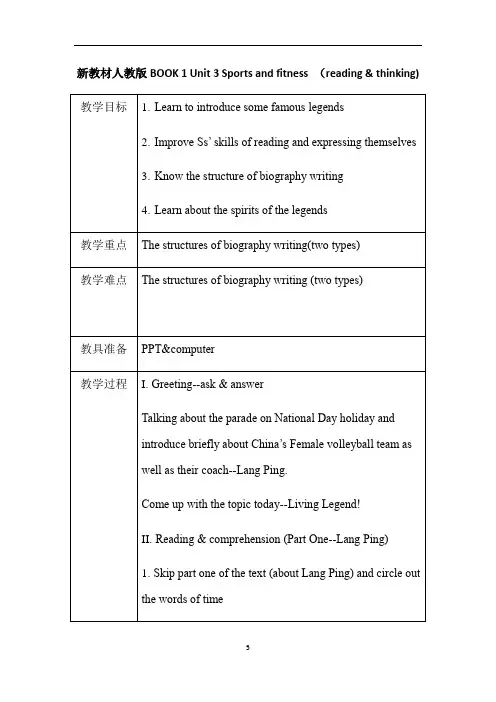
What does the author to describe? (experience)
3.Talking about the structure
1In Lang Ping’s life experience, she has got three roles? What are they?And what does she do respectively?
in life: he has learnt to___________________
(e.g. The boys & Girls Club)
How does the author organize the information?
Draw a mind-map of this text
Compare the two kinds of structure of biography, summarize the way of writing biography
Come up with the topic today--Living Legend!
IIБайду номын сангаасReading & comprehension (Part One--Lang Ping)
1.Skip part one of the text (about Lang Ping) and circle out the words of time
IV.Post-reading
1.Discussion
1)Introduce Lang Ping or Michael Jordan with the expressions below(choose either of them)
高中英语新人教版精品教案《人教版新课标必修一第三单元reading教学设计》
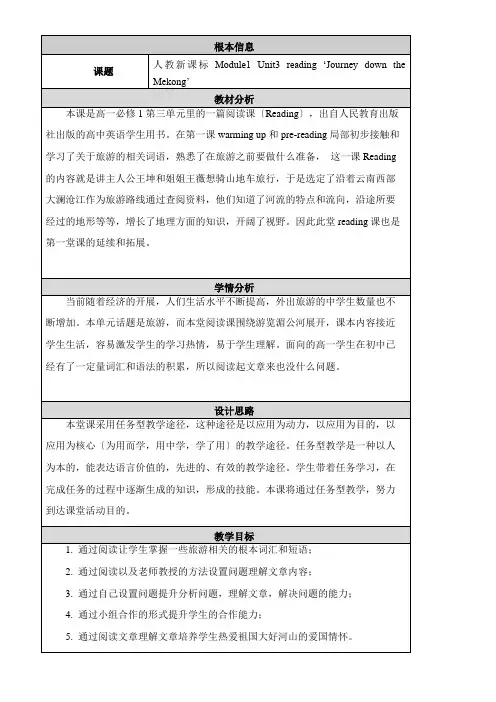
学生通过阅读文章,理解文章,然后就文章编阅读理解题来深层次理解文章内容。而出不仅使学生理解了文章,还培养学生联想、分析能力和逻辑分析能力〕。分组模式增强了学生的竞争意识,也活泼了课堂气氛。
Step2before reading
教师利用2021年新课标高考英语B篇的三道细节题教授学生如何基于细节出阅读理解题。
学生在做题过程中总结出三个出题技巧:词义转换;直接细节;细节归纳。
旨在让学生在做题中归纳总结,培养学生的逻辑分析能力和解决问题的能力,并为后面的阅读做铺垫。
Step3 while reading
教学目标
1.通过阅读让学生掌握一些旅游相关的根本词汇和短语;
2.通过阅读以及老师教授的方法设置问题理解文章内容;
3.通过自己设置问题提升分析问题,理解文章,解决问题的能力;
4.通过小组合作的形式提升学生的合作能力;
5.通过阅读文章理解文章培养学生热爱祖国大好河山的爱国情怀。
教学重点和难点
1.如何让学生准确运用三个出题技巧准确地就文章内容而出题。
Step5 homework
教师布置学生利用今天所学的三个阅读理解编题技巧对本单元的using language进行阅读理解题的编写
学生对本单元的using language进行阅读理解题的编写。
旨在利用这个练习使学生进一步熟悉并掌握三个出题技巧,同时还理解了using language里的那篇文章。
2.培养阅读时的联想、理解、前后联系的能力和逻辑分析能力。
教学辅助手段
PPT课件,黑板
高中英语人教版必修第一册Unit 3 Reading and Thinking 教学设计-
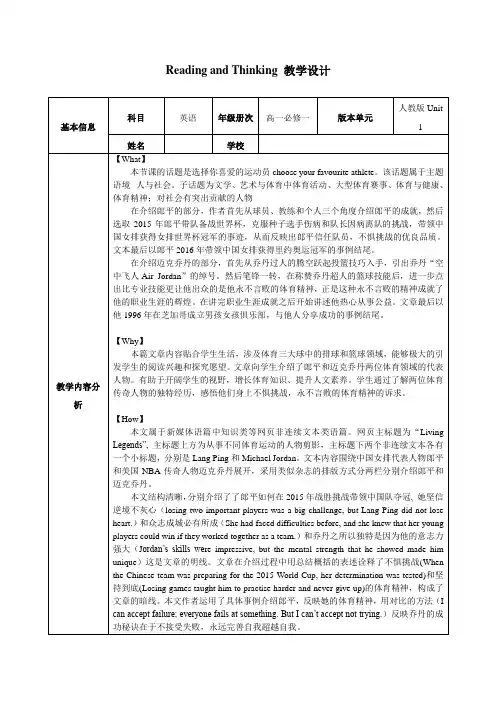
Reading and Thinking 教学设计基本信息科目英语年级册次高一必修一版本单元人教版Unit1姓名学校教学内容分析【What】本节课的话题是选择你喜爱的运动员choose your favourite athlete。
该话题属于主题语境--人与社会。
子话题为文学、艺术与体育中体育活动、大型体育赛事、体育与健康、体育精神;对社会有突出贡献的人物在介绍郎平的部分,作者首先从球员、教练和个人三个角度介绍郎平的成就,然后选取2015年郎平带队备战世界杯,克服种子选手伤病和队长因病离队的挑战,带领中国女排获得女排世界杯冠军的事迹,从而反映出郎平信任队员,不惧挑战的优良品质。
文本最后以郎平2016年带领中国女排获得里约奥运冠军的事例结尾。
在介绍迈克乔丹的部分,首先从乔丹过人的腾空跃起投篮技巧入手,引出乔丹“空中飞人Air Jordan”的绰号。
然后笔锋一转,在称赞乔丹超人的篮球技能后,进一步点出比专业技能更让他出众的是他永不言败的体育精神,正是这种永不言败的精神成就了他的职业生涯的辉煌。
在讲完职业生涯成就之后开始讲述他热心从事公益。
文章最后以他1996年在芝加哥成立男孩女孩俱乐部,与他人分享成功的事例结尾。
【Why】本篇文章内容贴合学生生活,涉及体育三大球中的排球和篮球领域,能够极大的引发学生的阅读兴趣和探究愿望。
文章向学生介绍了郎平和迈克乔丹两位体育领域的代表人物。
有助于开阔学生的视野,增长体育知识、提升人文素养。
学生通过了解两位体育传奇人物的独特经历,感悟他们身上不惧挑战,永不言败的体育精神的诉求。
【How】本文属于新媒体语篇中知识类等网页非连续文本类语篇。
网页主标题为“Living Legends”, 主标题上方为从事不同体育运动的人物剪影,主标题下两个非连续文本各有一个小标题,分别是Lang Ping和Michael Jordan。
文本内容围绕中国女排代表人物郎平和美国NBA传奇人物迈克乔丹展开,采用类似杂志的排版方式分两栏分别介绍郎平和迈克乔丹。
人教版高一必修一unit3reading教案精编版
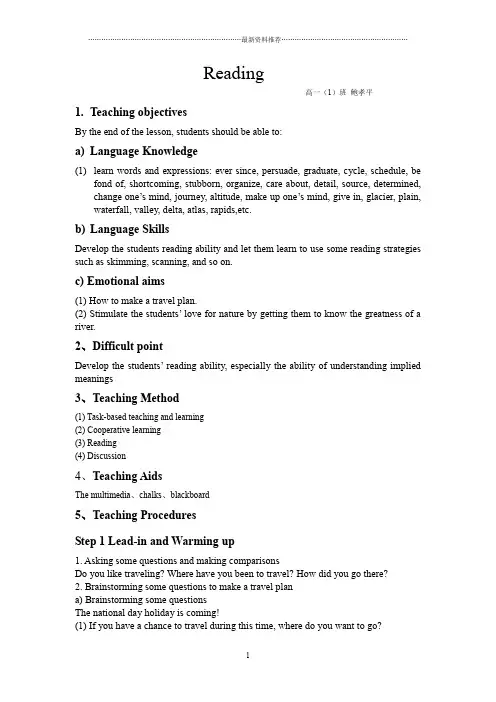
Reading高一(1)班鲍孝平1.Teaching objectivesBy the end of the lesson, students should be able to:a)Language Knowledge(1)learn words and expressions: ever since, persuade, graduate, cycle, schedule, befond of, shortcoming, stubborn, organize, care about, detail, source, determined, change one’s mind, journey, altitude, make up one’s mind, give in, glacier, plain, waterfall, valley, delta, atlas, rapids,etc.b)Language SkillsDevelop the students reading ability and let them learn to use some reading strategies such as skimming, scanning, and so on.c) Emotional aims(1) How to make a travel plan.(2) Stimulate the students’ love for nature by getting them to know the greatness of a river.2、Difficult pointDevelop the students’ reading ability, especially the ability of understanding implied meanings3、Teaching Method(1) Task-based teaching and learning(2) Cooperative learning(3) Reading(4) Discussion4、Teaching AidsThe multimedia、chalks、blackboard5、Teaching ProceduresStep 1 Lead-in and Warming up1. Asking some questions and making comparisonsDo you like traveling? Where have you been to travel? How did you go there?2. Brainstorming some questions to make a travel plana) Brainstorming some questionsThe national day holiday is coming!(1) If you have a chance to travel during this time, where do you want to go?(2) Who are going with you?(3) What do you ready to see?(4) How will you go there?(5) What are you ready to eat?(6) Where are you ready to live?(7) How much are you ready to spend?b) Making a travel plan with the given outline.……’s travel planWhere to go: I plan to go...Who are going with you: ... and IWhat to see: I will visit …How to go: We will go there ...What to eat:The food to taste are…Where to live: We could stay ...How much to spend: I plan to spend ...C) Talking and sharingAsking one students to share her/his plan.Making comments for that.Step 2 Fast Reading1. Background Information.a) Talking about the tile and saying some information about MEKONG river with some pictures.b) SkimmingThe students read the passage quickly and match the paragraph and the main idea. Step 3 Careful Reading(1)News words and expressions(2)ScanningI. Read the paragraph 1 with the recorder and answer some questions:i. Who have the dream and what the dream is?——Wang Kun and Wang Wei. The dream is talking about a great bike dream.II. Read the paragraph 2 with the recorder and answer some questions:i. What was Wang Wei’s idea of the difficulties on the journey?——She was determined and excited.ii. Who finally gave in? Why?——Wangkun had to give in. Because Wangwei would not change her mind when she determined.iii. What does Wang Kun think of Wang Wei?——She was really stubborn.III. New words for paragraph 3 with pictures.IV. Read the paragraph 3 with the recorder and answer some questionsi. Where is the source of the Mekong and which sea does it enter?——The source of the Mekong is Qinghai province and it enters South China Sea. ii.What can you see when you travel along the Mekong?——You can see the source glacier ,rapids, hills, valleys, waterfalls and plains.iii. What difficulties did Wang Kun and Wang Wei find about their journey?——The journey will begin at an altitude of more than 5,000 metres, where it is hard to breathe and very cold.iv. Where is the source of the Mekong and which sea does it enter?——The source of the Mekong is Qinghai province and it enters South China Sea. v.What do you think about Wang Kun and Wang Wei?——Wang Kun: enthusiastic, critical, sensibleWang Wei: imaginative, organized, eager, persistent, stubborn, risk-takingV. SummaryStep 4 Homework1、Page 20, exercise 1、2、32、Set down the useful words and expressions in the text.。
人教版英语必修一Unit 3(Reading:Journey down the Mekong)教案
Reading: Journey down the Mekong教案
Part 1:The Dream and The plan
Time:September 27,2016
Place:HuizhongMiddle school
Teacher:党连霞
School:永靖中学
Para. 3The preparations before the trip & details about theMekongRiver.
•Who are Wang Kun and Wang Wei?
•What is their dream?
。Who are Dao Wei and Yu Hang?
4.Sometimes, the river becomes a ________ and enters ____ ______.
5.At last, the river _____ enters the South China Sea.
6.If you travel with them ,you will see all the following except
A. desert B. a waterfall
C. a delta D. a glacier
通过skimming及scanning阅读策略,引领学生关注文本的主题及涉及主题的主要信息。(也是这节课的重点和难点)
Step 4:Summary
Wang Wei and ____.___ have dreamed about ____ a great ___ ___.It was Wang Wei who first had the idea to ____ along the entireMekongRiver. My sister doesn’t ___________ details, because she doesn’t know the best way of getting to places.
人教版英语必修一Unit 3(Reading:Journey down the Mekong)教学设计
人教版Unit3 Reading Journey down the Mekong教学设计辽宁师大附中庞春艳一、教材分析本课是人教版必修一第三单元的一篇阅读课。
文章是一篇记叙文,主人公王坤以旅行日志的形式讲述了和姐姐王薇想骑山地车旅行,并为这次旅行查阅资料做准备的过程。
文中的湄公河在中国境内被叫做澜沧江,是一条跨越六个国家的国际性河流。
湄公河海拔5000多米,空气稀薄,他们所选择的旅行路线注定是一次非常刺激的旅行经历。
本篇文章为后面的游记提供了背景知识,是本单元的重点文章,属精读内容。
二、学情分析我所授课的年级为高一学生,他们在经过了将近一个月的高中生活后基本适应了高中的英语教学模式。
另外,人们对于旅游这个话题都非常感兴趣,尤其是他们这个年龄段的孩子,有热情,敢于冒险。
但是高一学生对阅读技能的掌握需要一点点培养,所以在设计课的过程中,要考虑阅读技能的训练。
三、教学目标Teaching objectives1.Knowledge and skills:Students will be able to1)pick out useful information and get the main idea of the reading passage.2)develop their reading ability by skimming, scanning and so on.3)understand and master some words and expressions related to geography.4)give a description of the Mekong River and know how to make a plan for a trip2.Emotional attitude and valueStudents will be able to1)have a basic knowledge of the background of the Mekong River and develop an interest in traveling.2)get into a good habit of being prepared and persistent.四、教学重点The training of the reading skills and the full understanding of the text五、教学难点The analysis of the characters of Wang Kun and Wang Wei and how to give a description of the Mekong River六、教学方法Communicative strategy, task-based strategy, cooperative learning七、教学过程【体现教学目标达成、教学重难点突破、教法学法说明】八、 板书设计。
人教版英语必修一Unit 3(Reading)教学教案
Unit3 Travel JournalReading(Part1: Journey down the Mekong River)Analysis of the teaching materialThe teaching material used in this lesson is the NEW SENIOR ENGLISH FOR CHINA:STUDENT’S BOOK 1, PEP version, which is written on the base of task-based language teaching concept. Its topics are related to students’ daily life and that helps to arouse the students’ learning interest.The topic of unit3 in the textbook is about travel, enabling the students to know something about countries or regions by traveling, such as local conditions and customs, geographical characteristics and climate features. Reading is the first part of the journal. it tells the story of Wang Kun and Wang Wei's bike travel dreams and plans, describes what they have done for the tour, such as selecting the route and looking at maps to get information about the Mekong river. The journal is written in the first person. Through the introduction to Wang Wei’s way of doing things, we have a deep impression on her characteristics.Teaching goals1.Knowledge goalLearn something about the Mekong River through reading.2.Ability goal(1) To develop the students ’ability of reading, such as scanning, skimming and detailed reading.(2) To cultivate the students’ ability of cooperation3.Affective aimsStudents should realize if they want to be successful, what personalities they should have.Teaching important and difficult points:1.Understand the text well.2.How to grasp the main idea of the textTeaching methodsTask-based language teachingTeaching aids: a computer & a projectorTeaching proceduresStep ⅠLead In(1minute)T: Q1: Have you visited any river?Q2: How many great rivers do you know?Q3: If you can travel down only one of them, which one would you choose? Why?Show pictures and maps of some famous rivers in China, students tell their names. (The Yellow River, the Changjiang River, the Pearl River and the Mekong River)Step ⅡPre-reading(2 minutes)T: Have you visited the Mekong River? If no, let’s learn something about it.1. Show a map of the Mekong River and the brief introduction of it. Ask them:Can you list the countries that the Mekong River flows through?Step ⅢReading(26minutes)In this step, get the students to read the text and finish some tasks.Fast-reading:Task1: Scan the text quickly, and then answer some questions (10minutes):Q1. What is the main idea of each paragraph?Q2.where is the source of the Mekong River and which sea does it enter?Evaluation way: oral evaluation made by students.Detailed-readingTask2:The whole read paragraph 1 loudly and find out the answer of the following questions: (4minutes)Q1、What is Wang Kun and Wang Wei’s idea of a good trip?Q2、Who are Dao Wei and Yu Hang?Q3、Who plans the trip to the Mekong?Evaluation way: oral evaluation made by teacher.Task3:Listen to the tape of paragraph 2 carefully, and then finish the True orFalse questions: (4minutes)1. Wang Wei thinks that her way is the proper way.2. Wang Wei is a stubborn and careful girl.3. The journey is difficult because it begins at an altitude of more than 5,000 meters, where it is hard to breathe and very cold.Evaluation way: oral evaluation made by teacher.Task4:Role-Play. Suppose that one student is guide, the others are foreigners going to travel along the Mekong River, please the guide to introduce to the foreigners about what they can see during the journey. Read paragraph 3 carefully first. (4minutes).Evaluation way: oral evaluation made by students.Task5: Consolidation: retell the passage and fill in the blanks (4minutes)Wang Kun and Wang Wei had ________ (dream) of taking a bike trip for a long time. After they graduated _____ college, they were ___________ (determine) to cycle along the Mekong River. In order to do the trip __________ (proper), they went to the library and found a large atlas with good _____(map) in it. After a careful study to the maps, they found the source of the river and made up ______ mind to begin their journey ____ an altitude of 5,000 meters. During their journey, they could enjoy the ________(beauty) scenery of glaciers, deep valleys, waterfalls and plains.Evaluation way: oral evaluation made by teacher.Step IV Post-reading (10minutes)Task 6:Make comparison (5minutes)An attitude is what a person thinks about something. Make lists of Wang Wei’s and Wang Kun’s similar and different attitudes about the trip.Evaluation way: oral evaluation made by groups.Task 7: Debate (5minutes)Which character do you like, Wang Kun or Wa ng Wei? Why?Evaluation way: oral evaluation made by teacher.Step V Homework (1minute)1. Read the text again.2. Write a passage about your own travel experience.。
人教版高一英语必修1Unit3Reading说课稿
人教版高一英语必修1 Unit 3说课稿Travel Journal (Reading)Journey Down the Mekong一教材分析这节课使用的教材是新课程标准实验教材高中英语必修一。
这套教材是在任务型语言教学理念的基础上编写的。
以话题为主线,贴近学生生活,贴近真实的教学行为。
它的语言教学理念是强调语言的运用,促进学生自主学习,发展学习的策略,培养创新精神,突出实践能力。
本单元的话题是Travel Journal,Reading是整个单元的核心部分,是上一课时Warming up的延续和升华,也是后面第二篇阅读文章的引子;另外,大部分的重要词汇和语法也在这个课时中呈现出来。
文章讲述王坤和姐姐王薇的一次长途单车之旅的梦想,计划。
还介绍了湄公河的大致情况。
文章的学习能激发学生对大自然的热爱与向往,也唤起学生保护河流及自然环境的意识。
1. 教学目标①知识目标掌握重点词汇、短语:ever since; persuade ;graduate; stubborn ;organize; journey; valley; be fond of ;care about; change one`s mind ; make up one`s mind; give in 。
掌握重点句子:It was my sister who had the the idea to cycle along the entire Mekong River from where it begins to where it ends.When are we leaving and when are we coming back ?Where are we going ?4 My sister and I have dreamed about taking a great bike trip.5 Although she didn`t know the best way of getting to places ,she insisted that she organize the trip properly.②技能目标通过skimming,scanning , careful reading ,generalization ,inference 等阅读技能训练,提高阅读能力和阅读技能,培养学生获取信息、处理信息、运用信息进行推理、判断和总结归纳的能力。
- 1、下载文档前请自行甄别文档内容的完整性,平台不提供额外的编辑、内容补充、找答案等附加服务。
- 2、"仅部分预览"的文档,不可在线预览部分如存在完整性等问题,可反馈申请退款(可完整预览的文档不适用该条件!)。
- 3、如文档侵犯您的权益,请联系客服反馈,我们会尽快为您处理(人工客服工作时间:9:00-18:30)。
Reading
高一(1)班鲍孝平
1.Teaching objectives
By the end of the lesson, students should be able to:
a)Language Knowledge
(1)learn words and expressions: ever since, persuade, graduate, cycle, schedule, be
fond of, shortcoming, stubborn, organize, care about, detail, source, determined, change one’s mind, journey, altitude, make up one’s mind, give in, glacier, plain, waterfall, valley, delta, atlas, rapids,etc.
b)Language Skills
Develop the students reading ability and let them learn to use some reading strategies such as skimming, scanning, and so on.
c) Emotional aims
(1) How to make a travel plan.
(2) Stimulate the students’ love for nature by getting them to know the greatness of a river.
2、Difficult point
Develop the students’ reading ability, especially the ability of understanding implied meanings
3、Teaching Method
(1) Task-based teaching and learning
(2) Cooperative learning
(3) Reading
(4) Discussion
4、Teaching Aids
The multimedia、chalks、blackboard
5、Teaching Procedures
Step 1 Lead-in and Warming up
1. Asking some questions and making comparisons
Do you like traveling? Where have you been to travel? How did you go there?
2. Brainstorming some questions to make a travel plan
a) Brainstorming some questions
The national day holiday is coming!
(1) If you have a chance to travel during this time, where do you want to go?
(2) Who are going with you?
(3) What do you ready to see?
(4) How will you go there?
(5) What are you ready to eat?
(6) Where are you ready to live?
(7) How much are you ready to spend?
b) Making a travel plan with the given outline.
……’s travel plan
Where to go: I plan to go...
Who are going with you: ... and I
What to see: I will visit …
How to go: We will go there ...
What to eat:The food to taste are…
Where to live: We could stay ...
How much to spend: I plan to spend ...
C) Talking and sharing
Asking one students to share her/his plan.
Making comments for that.
Step 2 Fast Reading
1. Background Information.
a) Talking about the tile and saying some information about MEKONG river with some pictures.
b) Skimming
The students read the passage quickly and match the paragraph and the main idea. Step 3 Careful Reading
(1)News words and expressions
(2)Scanning
I. Read the paragraph 1 with the recorder and answer some questions:
i. Who have the dream and what the dream is?
——Wang Kun and Wang Wei. The dream is talking about a great bike dream.
II. Read the paragraph 2 with the recorder and answer some questions:
i. What was Wang Wei’s idea of the difficulties on the journey?
——She was determined and excited.
ii. Who finally gave in? Why?
——Wangkun had to give in. Because Wangwei would not change her mind when she determined.
iii. What does Wang Kun think of Wang Wei?
——She was really stubborn.
III. New words for paragraph 3 with pictures.
IV. Read the paragraph 3 with the recorder and answer some questions
i. Where is the source of the Mekong and which sea does it enter?
——The source of the Mekong is Qinghai province and it enters South China Sea. ii.What can you see when you travel along the Mekong?
——You can see the source glacier ,rapids, hills, valleys, waterfalls and plains.
iii. What difficulties did Wang Kun and Wang Wei find about their journey?
——The journey will begin at an altitude of more than 5,000 metres, where it is hard to breathe and very cold.
iv. Where is the source of the Mekong and which sea does it enter?
——The source of the Mekong is Qinghai province and it enters South China Sea. v.What do you think about Wang Kun and Wang Wei?
——Wang Kun: enthusiastic, critical, sensible
Wang Wei: imaginative, organized, eager, persistent, stubborn, risk-taking
V. Summary
Step 4 Homework
1、Page 20, exercise 1、
2、3
2、Set down the useful words and expressions in the text.。
